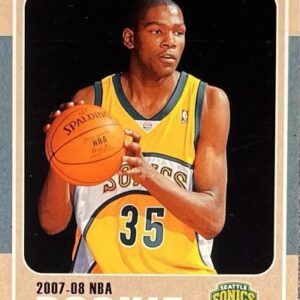In a hobby awash with glittering options, there’s one sports card that holds an almost gravitational pull on collectors, both seasoned and novice—LeBron James’s 2003 Topps #221. This iconic piece bridges the divide between eras: a slice of nostalgia resting comfortably in the wave of the chrome-obsessed new age. Imagine it, a snapshot engrained in memory, heightened by its presence in countless conversations among prospective collectors. It’s the card friends often suggest when nostalgia kicks in, a starting point for those rekindling their love affair with card collecting.
While the card does not boast the shimmering allure of rarer LeBron rookies, it embodies the trustworthy cornerstone many seek. Its availability presents an accessible challenge while meeting collector demands with ease. The past few months have been testament to its compelling charm. As the summer of 2025 unfolded, bidding wars on eBay saw PSA 10 examples trading in a tight band: from $2,000 to $2,175, with sales on August 6 at $2,000, followed by incremental shifts each day. This consistency shows that even in an unpredictable market, this card remains a steady anchor.
Looking at broader trends, the card’s solid foundation is apparent. According to Card Ladder, a PSA 10 garnered $2,531 in late August—indicative of a modest upward trend since spring. There are no steep inclines here, just a measured climb backed by stable volume, underlining its appeal to collectors as a reliable investment.
Topps offered more than just the base version, understanding the collector’s thirst for variety and scarcity. They introduced intriguing variants like the Black Border parallel, capped at five hundred, and the Gold variant, limited to ninety-nine. Then there’s the First Edition stamp, providing a unique twist without venturing into serialized territory—these are the iterations that frequently pop up on pricing platforms.
An interesting sibling to the base card is the Topps Collection photo variation, a slightly eccentric offshoot with its distinctive image. Though often trailing the base version in value, in mint condition, it’s a welcome detour for set-builders loyal to the flagship line.
Grading undeniably influences the card’s narrative. With a healthy population of PSA 10s, this card trades less like a mythical specter and more like a blue-chip stock. Yet, the leap from a PSA 9 to a PSA 10 carries weight, not just in financial terms but also in the minds of collectors. If you’re just dipping your toes back in, raw versions flirt with prices between $250 to $300, while PSA 9s hover around the $400 mark. As always, centering, surface, and clear seller feedback play crucial roles—more so than mere enthusiasm—when it comes to finding the right piece.
If you adhere strictly to market comparisons, the playbook this month seems straightforward. Vigilance during evening eBay auctions for PSA 10s sees most falling in the $2,000 to $2,100 range, with the occasional price leap when passionate bidders play hardball. The card offers ample opportunities for studying price action due to its deep liquidity and constant watcher interest.
The paper versus chrome debate endlessly circles this rookie class, with chrome refractors strutting the peacock route. The paper Topps base, however, is the edition that lodged itself in numerous binders and collections since the mid-2000s, etching a legacy as the narrative connecting one hobby era to the next. It occupies a prime position on any essential LeBron list curated by guides like Cardboard Connection.
Centering often emerges as the primary quirk raised by collectors. With white borders highlighting any off-center tendencies, and the Black Border variant emphasizing each minute scratch, sharp corners and honest edges bear extraordinary significance. Spotting a perfectly centered PSA 10 still delivers a thrill, as it earns each score point.
Different financial scopes have clear pathways; a robust PSA 9 permits enjoyment of the flagship design at a fraction of gem prices and remains investment-worthy for future dealings. A well-centered raw card can morph into a satisfying grading endeavor. For those with a taste for rarity, the First Edition offers complexity sans the steep premiums associated with Black and Gold versions. The essence isn’t in chasing the internet’s favored option, but in aligning your personal flair with the version that feels right in your hands.
And indeed, you might strike gold by pulling one from the wild. Our Galaxy Rip Packs occasionally house 2003 Topps LeBrons, curated for genuine thrill without diving into mere hopefulness. Though the contents rotate, the promise lingers, making the experience of ripping packs unequivocally exhilarating.
Examining the card in 2025 illustrates that its status needs no embellishment. The checklist, recent bid figures, and the card’s widespread appeal among collectors speak volumes. Whether you plan to hold onto one long-term, swap into one post-shows, or gamble your way to ownership, few basketball cards offer such dependable value. Even when exploring its illustrious siblings—the Black and Gold numbered editions or the First Edition—you find yourself following the gravitational orbit around a card that continues to captivate the collector spirit.





